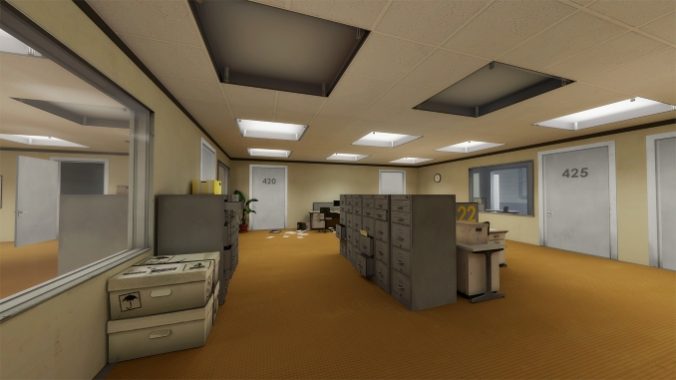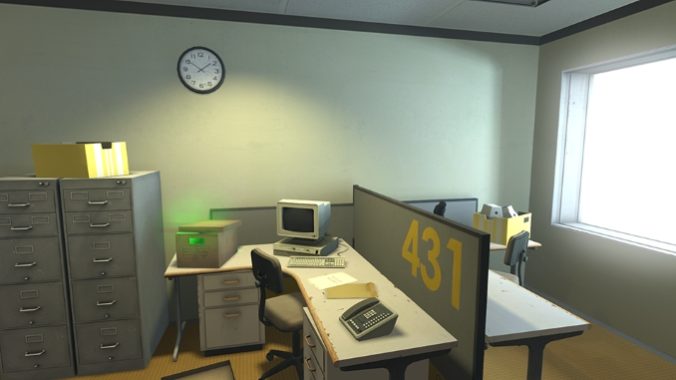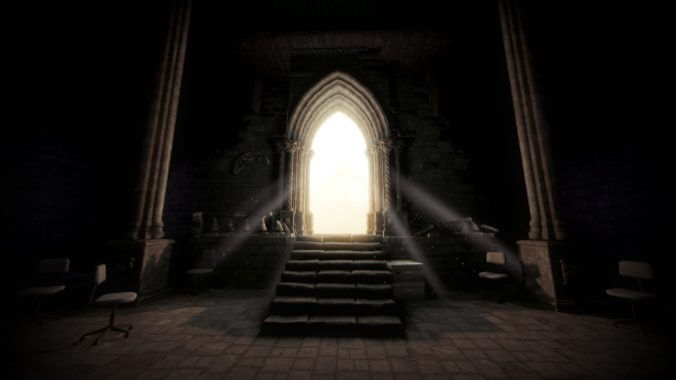The Stanley Parable and The Backrooms Honor Horror’s Yellow History
Games Features The Stanley Parable
There’s an ongoing chicken-egg discussion that I’ve stumbled across of late: is The Stanley Parable the origin of The Backrooms or is it the other way around? This seems like a simple matter of chronology at first blush, as The Stanley Parable and its liminal office spaces have existed since 2011. And The Backrooms creepypasta about how to “noclip out of reality” into a nightmarish purgatory of modern office backrooms originated in 2019. For those who are unaware, The Backrooms is an internet myth that has become perhaps one of, if not the most, emblematic examples of alternate reality and liminal space. The attendant image especially, perfectly described in the creepypasta as “nothing but the stink of old moist carpet, the madness of mono-yellow [surroundings], the endless background noise of fluorescent lights at maximum buzz,” has become instantly synonymous with the term liminal. And similar to Stanley’s ever-transforming, labyrinthine office, The Backrooms is suggested to have “approximately six hundred million square miles of randomly segmented empty rooms to be trapped in.”
But as one snarky Reddit user remarked in one of the many discussions about which spawned the other, Stanley didn’t invent offices and their attendant uncanny atmosphere. Muddling things further, The Backrooms is a creepypasta that both directly references videogames as structural art form and has also produced a videogame (one that apparently is referenced in Stanley’s Ultra Deluxe Remake). The most baffling notion I’ve encountered while following this ouroboros thread is that some people believe that The Backrooms came first. But what’s even more baffling is that they’re not necessarily wrong.

Stanley and The Backrooms are tied to a long tradition of the liminal in horror. While Stanley portrays a more Douglas Adams-esque absurdist version of being caught in-between states, it technically still has at its core a hollowness that makes one’s amused laughs at the omniscient narrator’s jibes often turn slightly hysterical. Stanley is known for its brilliant explorations of the relationship between a game’s creator and the player who, like Stanley, exists to press buttons and give silent input into a conversation between the creator’s design and a player’s desires. The game was originally released into an online zeitgeist that was often discussing how “meta” media was becoming. As such, Stanley delights in poking fun at players who often mined for self-referential gems from whatever was culturally relevant then.
The Backrooms is also very aware of its internet audience and the conversations that have pride of place amongst users in a paranoid and existential pandemic era. Who are we without the rhythm of commuting to and from work? In quarantine and sheltering in place for months on end, are we leading meaningless lives? Did work even give us any meaning in the first place, or were we projecting meaning onto the experience whilst distracting ourselves from the fact that just being is enough? Were our everyday routines a lie sold to us by those in power? And so on. One might say that tone is the main distinguishing feature of both these artistic explorations of liminal spaces. But I think there’s a more noticeable and seemingly superficial feature that binds them together: the color yellow (well, at least for the 2013 remake of Stanley onwards).
In horror, yellow is one of the most memorable yet ambiguous colors when used symbolically. As always, context is key, but predominantly, at least in literature, yellow stands for caution or deterioration (both physical and mental). Characters wearing the hue can sometimes be hopeful figures, calling to mind sunshine or a single light in the darkness. But when one thinks of the stories most associated with yellow, such as Frankenstein, The King in Yellow (which inspired some of H.P. Lovecraft’s Cthulu mythos), and The Yellow Wallpaper, they tend to be more existential and often feature characters that both figuratively and literally come apart at the seams. These characters are afraid of the tenuousness of reality and their place within its social constructs.

Stanley represents the sisyphean farce of modern work life and how both the interior and exterior space can be liminal in a capitalist society. Its yellow carpet and other details are the yellow of simulated or (as Clark Elieson references Heideggar’s term) enframed sunshine. Taking natural light and putting it into an office context where it feels uncanny. Yellow can also sometimes reference cowardliness in the game. The Narrator often characterizes Stanley as a coward who won’t follow the path set out for him, a simpleton who would prefer to stay in his office mindlessly pressing buttons instead of setting out to find out why he’s occupying a liminal space all of a sudden.
Two of my favorite Stanley endings, Mariella and Out the Window (yes, you should be concerned for me), exemplify how The Narrator jeers Stanley’s quest for meaning in the surreal and sometimes extradimensional space of his office. The Window ending in particular even references noclipping into a different space/reality. In the Mariella ending, Stanley is found dead on the pavement by a woman named Mariella who perceives the office as a wonderful space that she can’t wait to go to because she’s going to receive acclaim as an employee there and coldly dismisses Stanley’s corpse as that of a mad person.
The Backrooms are akin to a fungal, sickly yellow. The yellow of musty exclusively interior spaces that one can become lost in, both physically and psychologically. Its yellow is much more cautionary and desolate. The Backrooms are also a labyrinth that contains a hostile unnamed presence the creepypasta narrator warns the reader/potential noclipper of.
There is a psychological overlap regarding decay however. Many endings of Stanley show graphical decay or unfinished spaces, ones The Narrator actively tries to prevent Stanley from seeing or accessing because (similar to Gromit furiously laying down tracks whilst atop the toy train that runs them) he’s busily constructing the space as Stanley is exploring. The Narrator sometimes torments or kills Stanley in these unfinished spaces through psychological terror (such as when you decide to go down the stairwell instead of up to Stanley’s boss’ office) but sometimes just incites Stanley’s fears of death as well. This is the case for the ending where The Narrator explains to Stanley that he is actually wasting his life at the office and is estranged from his wife or the interlude that occurs when you hide in the broom closet. Whenever The Narrator becomes very frustrated with Stanley, he’ll often explain Stanley’s/the player’s illogical actions as meaning that he’s dead or lost control of his consciousness either through stupidity or madness.
A last note to think on regarding the intertwined nature of The Stanley Parable and The Backrooms is this: both of these liminal spaces involves the consumer or player in the narrative by presenting the space as representative of what their POV is. Although Stanley is shown once at the start of his narrative, his journey is perceived by the player from the same first-person vantage point of the reader of The Backrooms creepypasta. And both are hounded by a hostile unnamed presence, even if one of them is a lot more charismatic and dryly sarcastic about it. And this hostile nature of a liminal space and how The Backrooms references it from a long horror tradition belies how at the yolk of the matter, both the game and creepypasta are bound together.
Phoenix Simms is an Atlantic Canadian writer and indie game narrative designer. You can find her work at Unwinnable, Videodame, Third Person, and her portfolio. Her stream-of-consciousness can be found at @phoenixsimms.